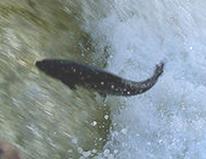 [5]Genetically engineered fish is answer to seafood crisis
[5]Genetically engineered fish is answer to seafood crisis
By James Greenwood
CEO of the Biotechnology Industry Organization [6]
Right now, the government is deciding whether it’s safe for us to eat genetically engineered salmon. The fish, called AquAdvantage, is being developed by a Massachusetts biotech firm and is in every measurable way identical to Atlantic salmon—except it grows to normal size twice as fast. If officials at the Food and Drug Administration (FDA) give it the green light, it would be the first time that a genetically engineered animal is approved for food use.
Genetic engineering usually conjures up images of Frankenstein. But modern day biotech researchers are anything but mad scientists. Their ground-breaking work has the potential to address world hunger and protect the environment. The AquAdvantage salmon in particular could ease pressure on wild fish stocks, reduce the environmental impact of traditional fish farming, and help feed the growing world population.
Overfishing and pollution are quickly wiping out the native global fish supply. Already 80% of fish stocks world-wide are fully exploited or overexploited, according to a May 2010 U.N. report. If current trends continue, virtually all fisheries risk running out of commercially viable catches by 2050.
Fish farming has helped address this problem: About half of seafood consumed world-wide is now farm-raised. But it’s expensive. Shipping farm-raised salmon to the United States from Chile, where most of our fish originates, costs as much as 75 cents per pound.
Faster-growing genetically engineered salmon could help restore America’s domestic fish farming industry, trimming costs and reducing energy consumption. If the FDA approves the fish it would also spur investment in other food products. This could help meet the world’s growing demand for protein-rich food.
Through biotechnology, scientists at a firm in South Dakota have developed cattle that are resistant to mad cow disease. Canadian researchers have asked the FDA to approve their “Enviropig,” a pig genetically engineered to produce manure that is less polluting. Biotech researchers are also exploring ways to fortify food plants with enhanced nutritional content, which could help alleviate malnutrition and certain diseases in the developing world. And researchers are engineering animals that can better utilize nutrients in feed.
Critics contend that genetically engineered fish haven’t been sufficiently researched and could harm our health. But the truth is that these faster-growing salmon are the result of more than two decades of research. Plus, the FDA’s system to ensure the safety of such animals has been in development for over a decade.
There’s nothing peculiar about this fish’s genetic makeup. To create the faster-growing salmon, scientists took a gene from the Chinook salmon, which matures rapidly, along with a gene from a salmon relative called ocean pout, which produces growth hormones all year. Aside from these two tweaks, the AquAdvantage salmon is chemically and biologically identical to the salmon we purchase at the local grocer.
Critics also fear that these salmon could crossbreed with wild fish and pollute their gene pool. This is highly unlikely given the protections put in place and the realities of the science. By treating the genetically engineered eggs, all AquAdvantage salmon will develop as sterile females. And these fish will be grown in contained, land-based tanks, away from any interaction with wild fish and the ocean.
When genetically engineered crops were introduced 14 years ago, critics worried that “frankenfood” would hurt human health and the environment. Since then, farmers have grown corn, soybeans, cotton and other products that are resistant to disease and pests, and tolerant of herbicides. These innovations have reduced production costs, increased agricultural productivity and reduced agriculture’s footprint on the environment. To date, not a single adverse health effect has been caused by a food derived from genetically engineered crops.
Genetically engineered animals are the next intelligent step in food innovation. As Josh Ozersky, a James Beard Award-winning food writer, has observed, “There are no Black Angus cows grazing in the wild; they’re the product of breeding for size, marbling and fast growth, not unlike the genetically-modified salmon.”
Public dialogue on any new technology is important. But the discourse must be based on sound science. And regarding faster-growing salmon—and other genetically engineered foods of the future—science shows clearly that they can provide us with the safe and sustainable food source we need.
Mr. Greenwood is president and CEO of the Biotechnology Industry Organization.